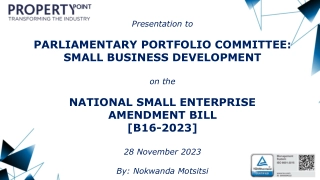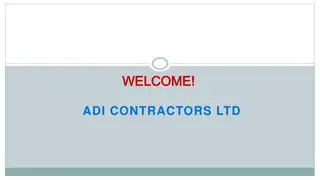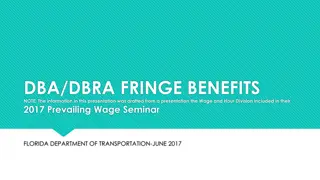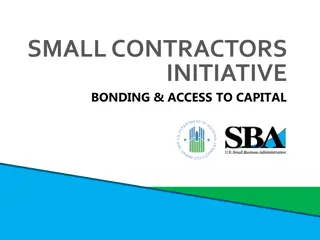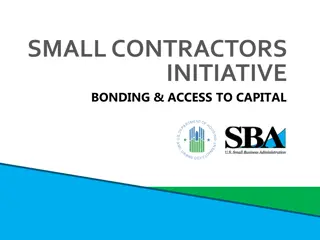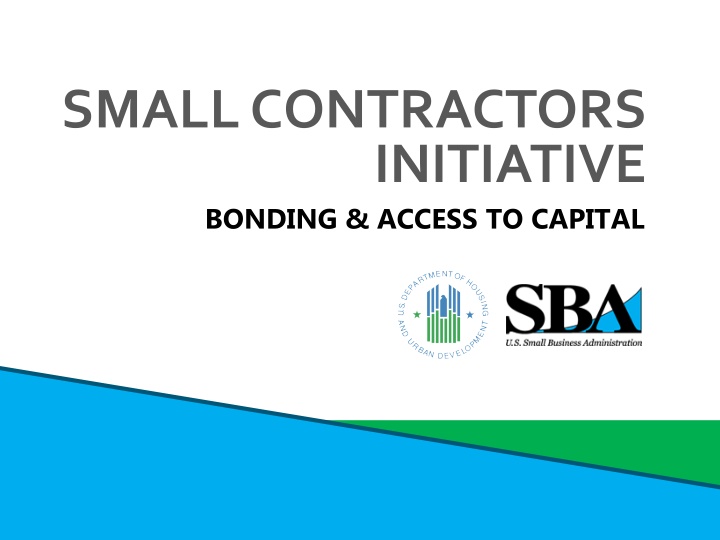
Accounting Systems for Small Contractors
Learn how small contractors can manage their finances effectively to access capital and bonding. This session covers accounting components, financial statements, financial ratios, and more essential for financial management in the construction industry.
Download Presentation

Please find below an Image/Link to download the presentation.
The content on the website is provided AS IS for your information and personal use only. It may not be sold, licensed, or shared on other websites without obtaining consent from the author. If you encounter any issues during the download, it is possible that the publisher has removed the file from their server.
You are allowed to download the files provided on this website for personal or commercial use, subject to the condition that they are used lawfully. All files are the property of their respective owners.
The content on the website is provided AS IS for your information and personal use only. It may not be sold, licensed, or shared on other websites without obtaining consent from the author.
E N D
Presentation Transcript
SMALL CONTRACTORS INITIATIVE BONDING & ACCESS TO CAPITAL
SMALL CONTRACTORS INITIATIVE SESSION 4 FINANCIAL MANAGEMENT
SESSION OVERVIEW Introduction Part A: Accounting Components of Construction Accounting Financial Statements Accounting Methods Percentage of Completion Complete Contract Part B: Financial Reporting Financial Ratios Self-Evaluation Resources U.S. Dept. of Housing and Urban Development U.S. Small Business Administration 3
INTRODUCTION To obtain bonding and access to capital, the contractor s finances must be well managed. This session explains the basics of accounting systems used by construction firms. Part A focuses on construction accounting methods, Part B on reporting standards. U.S. Dept. of Housing and Urban Development U.S. Small Business Administration 4
PART A: ACCOUNTING U.S. Dept. of Housing and Urban Development U.S. Small Business Administration 5
PART A: LEARNING OBJECTIVES 1. Understand the components of an accounting system and financial statements. 2. Identify an accounting system that fits your business needs using generally accepted accounting principles. U.S. Dept. of Housing and Urban Development U.S. Small Business Administration 6
COMPONENTS OF CONSTRUCTION ACCOUNTING SYSTEMS U.S. Dept. of Housing and Urban Development U.S. Small Business Administration 7
FINANCIAL STATEMENTS Balance sheet. Profit and loss statement (statement of earnings). Changes in equity (this is less common). Cashflow. General Ledger. U.S. Dept. of Housing and Urban Development U.S. Small Business Administration 8
BASIC ACCOUNTING Accounting equation: Assets = Liabilities + Equity Net income: Net income = Revenues Expenses Changes in equity statement: Ending retained earnings = Beginning retained earnings Dividends paid + Net income Cash ratio: Cash ratio = Cash / Current Liabilities U.S. Dept. of Housing and Urban Development U.S. Small Business Administration 9
GAAP METHOD OF ACCOUNTING U.S. Dept. of Housing and Urban Development U.S. Small Business Administration 10
ACCEPTABLE CONSTRUCTION ACCOUNTING METHODS Note: Methods different from GAAP. U.S. Dept. of Housing and Urban Development U.S. Small Business Administration 11
PERCENTAGE COMPLETION METHODS U.S. Dept. of Housing and Urban Development U.S. Small Business Administration 12
PERCENTAGE OF COMPLETION METHOD Revenue recognized as received. Retention booked throughout the project. Expenses recognized as obligated. Estimated profits are distributed over time. Profit based upon projected revenues and expenses. U.S. Dept. of Housing and Urban Development U.S. Small Business Administration 13
COMPLETED CONTRACT METHOD Revenue earned at completion. Expenses booked at completion. Revenues and expenses are known. Provides no guidance for financial management. May create large swings in income. U.S. Dept. of Housing and Urban Development U.S. Small Business Administration 14
CONSTRUCTION ACCOUNTING SYSTEMS Hardware. Software/Cloud-Based. Features to look for: Estimating. Davis-Bacon payroll. Job cost and requisitions. Cost control. U.S. Dept. of Housing and Urban Development U.S. Small Business Administration 15
TOP 10 CONSTRUCTION ACCOUNTING PROGRAMS 2017 1. Jonas Enterprise 6. Spectrum Construction Software by Dexter & Chaney 2. Jonas Premier 3. Vista by Viewpoint 7. Foundation 4. Sage 300 CRE Connector by Procore 8. Penta 9. Axium Ajera 5. BuilderTrend 10. ComputerEase What do you use? U.S. Dept. of Housing and Urban Development U.S. Small Business Administration 16
CONSTRUCTION ESTIMATING ACCOUNTING BASICS Your calculated historic mark-up. Purchased databases. Negotiated rates. U.S. Dept. of Housing and Urban Development U.S. Small Business Administration 17
ESTIMATING FUNCTIONS Proposal generation. Cost database. Labor and material. Visual assemblies. Project reporting. What if? analysis. U.S. Dept. of Housing and Urban Development U.S. Small Business Administration 18
JOB COST LEDGER Provides breakdown of construction costs on income statement. May provide a breakdown of revenues on the income statement. Costs are broken down by: Job Phase (optional) Cost code Cost type U.S. Dept. of Housing and Urban Development U.S. Small Business Administration 19
JOB COST LEDGER EXAMPLE MATERIALS COST CODE LABOR PHASE # MATERIALS COST CODE LABOR MATERIALS COST CODE JOB # LABOR PHASE # MATERIALS COST CODE LABOR JOB COST LEDGER MATERIALS COST CODE LABOR PHASE # MATERIALS COST CODE LABOR JOB # MATERIALS COST CODE PHASE # LABOR MATERIALS COST CODE LABOR U.S. Dept. of Housing and Urban Development U.S. Small Business Administration 20
COST REPORTING VERSUS COST CONTROL U.S. Dept. of Housing and Urban Development U.S. Small Business Administration 21
COMPONENTS OF COST CONTROL SYSTEM MANAGEMENT BY EXCEPTION: Investigating only those situations in which actual results differ significantly from planned results. Strong job cost and equipment tracking. Costs must be current and up to date. Uses management by exception. Higher management is to mainly target and address strategic plans and decisions. Follows established procedures. Data must be readily available. U.S. Dept. of Housing and Urban Development U.S. Small Business Administration 22
ACTION PLAN Take 10 minutes to: Consider software options and needs. Identify choice. Incorporate into action plan. U.S. Dept. of Housing and Urban Development U.S. Small Business Administration 23
PART B: FINANCIAL REPORTING U.S. Dept. of Housing and Urban Development U.S. Small Business Administration 24
PART B: LEARNING OBJECTIVES 1. Understand basic financial ratios. 2. Evaluation compared to benchmarks. 3. Identify bond underwriting requirements. 4. Identify financial issues (red flags) for sureties. 5. Understand what working capital is, and why it is important. U.S. Dept. of Housing and Urban Development U.S. Small Business Administration 25
SURETIES (BONDING AGENTS) LOOK FOR Acceptable method of accounting. Related party transactions. Litigation/contingent liabilities. Totals and ratios: Assets, debt, etc. Backlog/billings over/under. Disclosure of an activity. U.S. Dept. of Housing and Urban Development U.S. Small Business Administration 26
KEY FINANCIAL RATIOS: DEFINITIONS Current ratio: Expresses the relationship of current assets to cover current liabilities. Generally, a ratio of 2 to 1 is considered a sign of good financial condition. However, much depends on the standards of the specific industry. For example, if a company's inventory is slow in selling, a stronger current ratio is required. Cash ratio: Represents a company's ability to pay current liabilities using only cash and cash equivalents on hand and is most commonly used as a measure of company's liquidity. If the company is forced to pay all current liabilities immediately, this metric shows the company's ability to do so without having to sell or liquidate other assets. The cash ratio is more useful when it is compared to industry averages and competitor averages. Working capital turnover Compares the depletion of working capital used to fund operations and purchase inventory, which is then converted into sales revenue for the company. The working capital turnover ratio is used to analyze the relationship between the money that funds operations and the sales generated from these operations. For example, a company with current assets of $10 million and current liabilities of $9 million has $1 million in working capital, which may be used in fundamental analysis. U.S. Dept. of Housing and Urban Development U.S. Small Business Administration 27
KEY FINANCIAL RATIOS GENERAL CONTRACTORS SPECIALTY TRADE CONTRACTORS CURRENT RATIO [CURRENT ASSETS] / [CURRENT LIABILITIES] 1.1+ 1.5+ CASH RATIO [CASH + CASH EQUIVALENTS + INVESTED FUNDS] / [CURRENT LIABILITIES] 0.2+ 0.35+ 10.0 - 2.0 6.0 - 10.0 WORKING CAPITAL TURNOVER [SALES] / [WORKING CAPITAL] U.S. Dept. of Housing and Urban Development U.S. Small Business Administration 28
DEBT-TO-EQUITY RATIO U.S. Dept. of Housing and Urban Development U.S. Small Business Administration 29
EXAMPLE TOTAL ASSETS $825,000 CURRENT ASSETS $748,000 CURRENT LIABILITIES $525,000 TOTAL LIABILITIES $650,000 EQUITY $175,000 SALES $2,000,000 CASH + CASH EQUIVALENTS $150,000 & INVESTED FUNDS U.S. Dept. of Housing and Urban Development U.S. Small Business Administration 30
WORKING CAPITAL U.S. Dept. of Housing and Urban Development U.S. Small Business Administration 31
WORKING CAPITAL TURNOVER Measures gross contract sales compared to working capital. Is working capital being leveraged to produce revenue? Working capital Turnover = Sales/working capital 8.97 = $2,000,000 / $223,000 U.S. Dept. of Housing and Urban Development U.S. Small Business Administration 32
DEBT-TO-EQUITY Measures equity capital leverage. Total liabilities (debt) equity $650,000 / $175,000 = 3.71 U.S. Dept. of Housing and Urban Development U.S. Small Business Administration 33
RED FLAGS FOR SURETIES Late financial statements. Errors in financial documents. Insufficient supporting schedules. Change in CPA (good/bad). Increases in non-construction activity. U.S. Dept. of Housing and Urban Development U.S. Small Business Administration 34
SELF-EVALUATION Take 10 minutes to review firm s reports in comparison to benchmarks. How can your firm improve reports? U.S. Dept. of Housing and Urban Development U.S. Small Business Administration 35
NEXT STEPS Link session material to action plan elements, as necessary. U.S. Dept. of Housing and Urban Development U.S. Small Business Administration 36
RESOURCES These resources provide more information on accounting: IRS: Construction Industry Audit Technique Guide (2009). National Association of Surety Bond Producers. Surety Information Office. U.S. Dept. of Housing and Urban Development U.S. Small Business Administration 37

